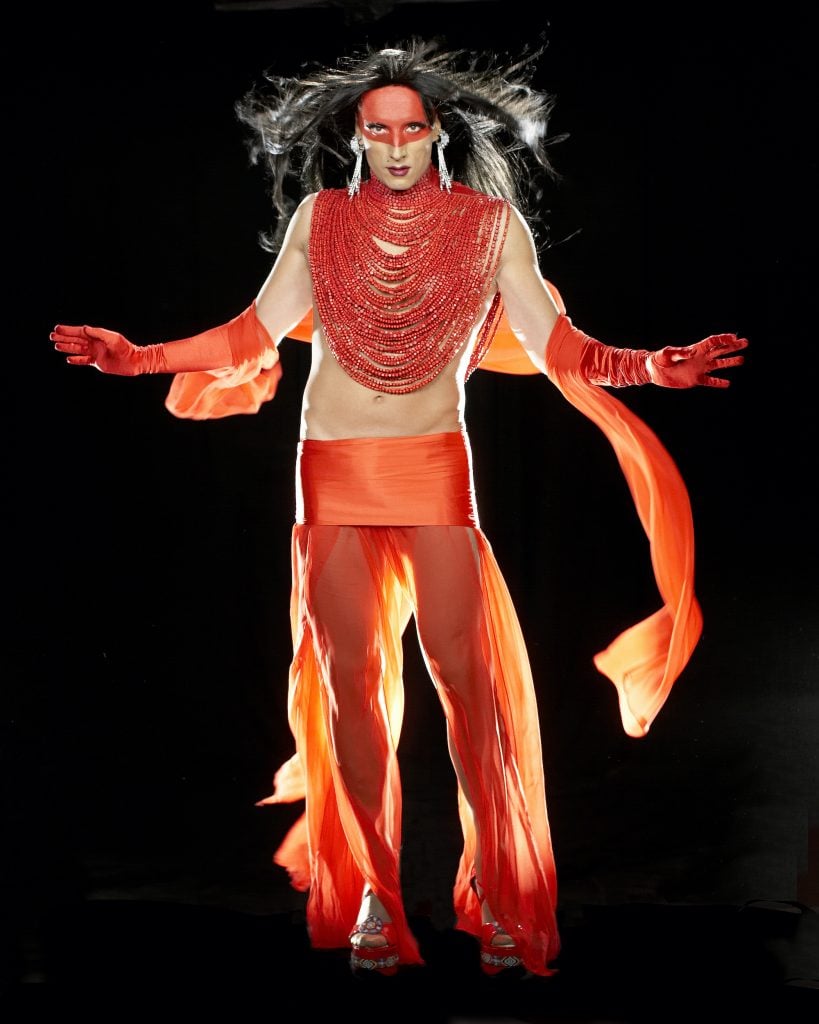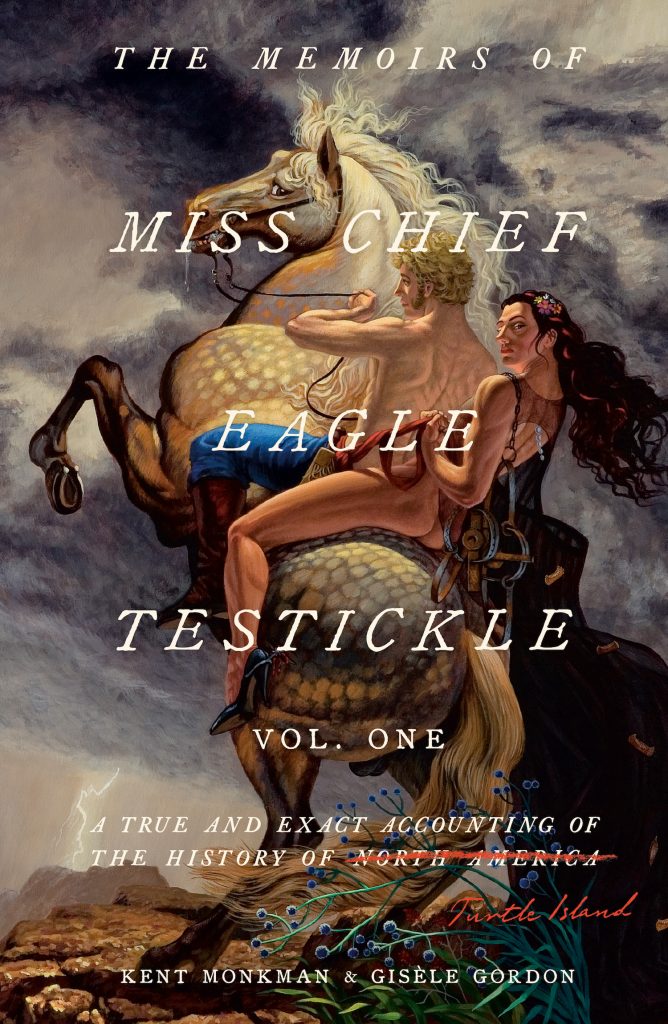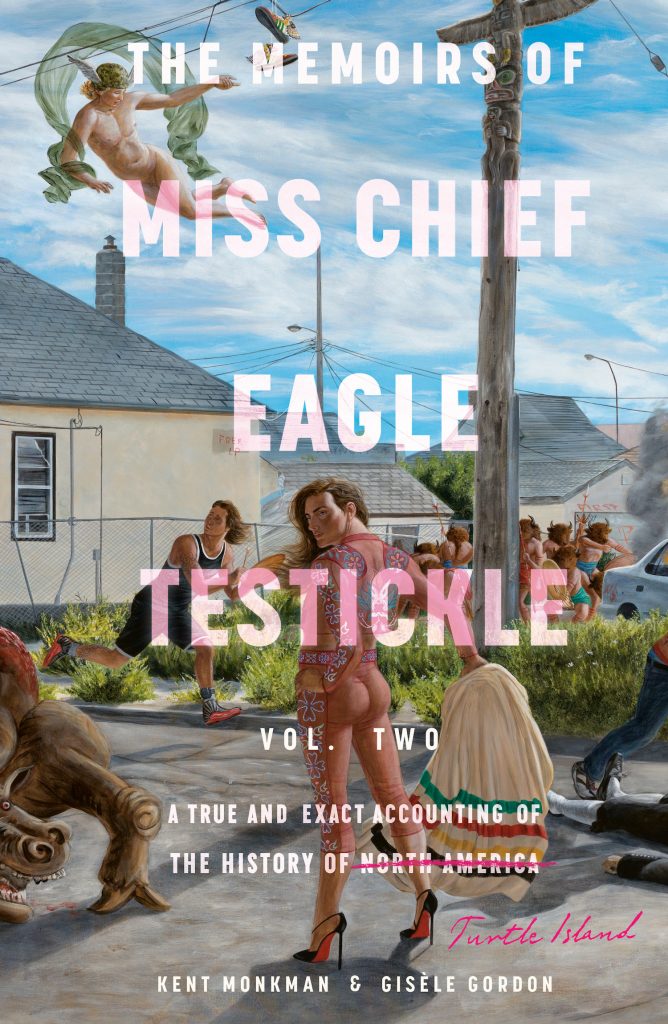Art World
A Fantastical Cree Spirit From the Mind of Artist Kent Monkman Writes Her Memoirs
Monkman and Gisèle Gordon, a longtime collaborator, spent six years writing the genre-defying book.

Monkman and Gisèle Gordon, a longtime collaborator, spent six years writing the genre-defying book.

Katie White

What if a painting could speak? What if a mythical figure on a canvas suddenly gained access to language and began to recount all that they’d seen across the eras of their many painted incarnations?
Cree artist Kent Monkman’s has given such voice to Miss Chief Eagle Testickle, his two-spirit alter-ego figure who has manifested in the artist’s films, performances, and paintings of Cree Indigenous history for years. Now she is speaking for herself as the narrator and storyteller of a new two-volume memoir, The Memoirs of Miss Chief Eagle Testickle: A True and Exact Accounting of the History of Turtle Island (2023), published in late 2023 by Penguin Random House. The book is the fruition of a six-year writing project between Monkman and his friend and longtime collaborator Gisèle Gordon. Lavishly illustrated with paintings by the artist (and featuring copious historical footnotes and a Cree lexicon), the memoir is a genre-defying journey through North American history as seen through queer Indigenous eyes. A dizzying and oftentimes delightful narrative, the memoir is epic in scope as Miss Chief recounts the darkest moments of colonial violence as well as playful romps with other legendary beings.
The memoir is unlike any other, and we recently sat down with Monkman and Gordon to learn how Miss Cheif’s memoir—part art object, part fantasy, part history—came into being.

Kent Monkman and Gisèle Gordon spent six years collaborating on the memoir. Photograph by Aaron Wynia.
Miss Chief has existed as a witness in Kent’s paintings and as an alter ego in performances for years. But where did the idea of Miss Chief writing her memoir come from?
Kent Monkman (KM): It started as a label text project—it wasn’t even a memoir idea. Gisèle helped me write label text for an exhibition that I did in 2017, which was a response exhibition to Canada’s celebrating its 150th birthday, called “Shame and Prejudice: A Story of Resilience” at the Art Museum at the University of Toronto. I was commissioned to create an exhibition that would be a sort of Indigenous response to Canada’s celebrating its birthday.
I decided that Miss Chief should narrate this story because she’s this legendary being and has existed and—well, we didn’t really know at that point how long she had been around—but she was clearly in the 19th century, engaging with politicians of that era, as well as artists like George Catlin, Albert Bierstadt, and Paul Kane. Even though she wasn’t in all of the paintings in the exhibition, it seemed to make sense that Miss Chief should narrate. I thought it would be an amazing way to create label texts for a visual art exhibition, but I struggled to write them. In fact, I was not getting very far along at all and with two weeks to go, I called Gisèle. Gisèle and I have collaborated for 30 years on film projects. She just jumped in and then wrote these concise, beautiful 120-word label texts. Until then, Miss Chief had just existed in painting and some performance mode, but she had no written voice yet.
Gisèle Gordon (GG): I have to say, I kept asking Kent for his draft of the labels, but there was no draft of anything. We had to start at the beginning. Miss Chief had a little bit of a playful voice from the performances. But I understand why Kent had writer’s block. Writing about colonial violence, which has had such a traumatic impact, with a voice that is still playful and still Miss Chief’s—we could never take that voice away—but without minimizing the impact of what Kent has depicted in his paintings, dealing with the legacy of colonial violence in a touring national exhibition, was quite a task. After we finished the labels, Kent started joking around that we should write her memoirs.
KM: The publisher of the memoir, Scott Sellers [Vice President of Penguin Random House Canada] actually saw this exhibition. We’d published the labels in Cree and French and English. He was so excited by the narrative he approached me with a book project. Instead of doing a straight book project, we thought would do Miss Chief’s memoir. That was back in 2017.
Real 19th-century artist journals in some ways shaped Miss Chief’s memoir, right? Can you tell me about that?
KM: Yes, we were thinking that this memoir would riff on the journal writing of artists like George Catlin and Paul Kane. I had read their journals and gleaned information from these artists. I wanted to get inside their heads. And that was how I created the character of Miss Chief—I was thinking about an artistic persona that could live in the work and reverse the gaze.
Where did you start? How much did Miss Chief’s story is tied to your existing artworks, Kent? How much was invented outside of it?
KM: We spent about a year with Gisèle coming to the studio and doing these intensive download sessions with me. We printed out all of these paintings where Miss Chief had appeared in my paintings over the last 20 years—printed them out and just laid them out in this long line in the studio and then started organizing those into chapters thematically. We focused on a hundred paintings that were inspired by Cree and Indigenous storytelling—circular storytelling. We did it again with a linear narrative just to wrap our heads around what her story would feel like as a basic scaffold.
GG: We went painting by painting. It was like each one was under the microscope. You could do a Ph.D thesis on each of these paintings—there are so many layers of art history, references, European settler, colonial history references, and Cree Indigenous references. Kent himself, sometimes after three hours of talking about a single work, he’d remember some new element too.

Volume 1 cover. Courtesy of Penguin Random House.
What did you both learn about Miss Chief through this process? Is she a deity? Who is she?
GG: Firstly, we realized we didn’t know where she came from. She had no origin story. We decided to engage with four Cree knowledge-keepers or Cree-language speakers since we wanted to focus this story from a Cree perspective—we didn’t want to make it a generic Indigenous story but rooted in the Cree language and with Cree ways of knowing.
One of these Cree knowledge-keepers was a theater artist whom we both collaborated with and a great writer and a great writer named Floyd Flavel. Another was Gail Maurice, who is a Cree language speaker, who’s an actor, filmmaker, and theater artist. Then we had two Dr. Keith Goulet, who is a doctor in the Cree language, and Dr. Belinda Daniels, who is a Cree language teacher.
Floyd actually knows the entire Cree creation story, which is given through protocol, and we still don’t know it entirely because parts of the story are sacred. But with Floyd giving us feedback, we were able to stitch Miss Chief into these stories connecting her to pre-legendary beings, and find a place for her. It’s a conversation you have to be careful with but she’s a kind of lesser legendary being, a younger sibling. They let us know what we could play around with and what we couldn’t.
What’s Miss Chief’s creation story? How does her story intersect with art history more broadly?
GG: We knew we needed to make a powerful myth for her because we’re fighting against these colonial histories and myths that we’ve all been indoctrinated with in school. Kent taught me through his work, but I’ve never thought about how deeply embedded art history paintings become part of your psyche, especially for a person like me who is a European settler. We had to fight myth with myth and create the most powerful myth that we could—in a compelling, funny, sexy story that tells you all kinds of truths about colonial history at the same time.
KM: The Cree creation story is that we come from the stars. In the memoir, Miss Chief emerges from the stars and plummets to Earth as a comet trailing pink gas. We were also interested in places where Western and Indigenous knowledge overlap. We spoke to Gisèle’s longtime friend Dr. Kim Venn who was an astrophysicist, and she corroborated the science, that the building blocks of life are from space and that we are the product of nuclear explosions.
Miss Chief appears in paintings set in the 19th century as well as in contemporary times. But when was she born? What epochs does the book traverse?
KM: We’re charting billions of years—an unknowable amount of time for puny human phrases. She begins as an elemental form and eventually plummets to Earth and takes on a human form. She was here before human beings existed. She interacts with dinosaurs. There’s this preamble about her waiting to fulfill her purpose.
GG: Of course, there’s a lot of fantasy and fiction in the book, but there’s a surprising amount of truth about colonial history and the secrets that have been written out. Sometimes, Kent had an instinct in his paintings about what might have happened but we ended up finding out it was true in our research.
Do you have any examples? Any favorite art historical vignettes in the book?
KM: I had come across the work of Alfred Jacob Miller, who was one of those American frontier artists in the 19th century. He described these rendezvous gatherings that he went to, with all these mountain men and trappers who would gather together in the spring. The traders would come and they would buy their furs and the trappers would buy whiskey. The way they described it these rendezvous gatherings were this very homosocial environment. I was reading between the lines with these descriptions because Alfred Jacob Miller described these gatherings but he didn’t paint them, because he was a Christian. Then, as it turns out, the patron who commissioned him to make these paintings who traveled with him was a gay Scottish lord who had traveled with a coterie of like-minded young men and trunks full of costumes and champagne. They were having these wild Paris parties in the Rocky Mountains. Gisèle discovered his story, his biography doing a deep dive. The truth is stranger than fiction in this case!
GG: Kent already made these wild paintings reimagining what he thought they were like, and his paintings were far closer to the truth than Alfred Jacob Miller’s paintings were. Miss Chief in the book befriends him and, you know, she’s having conversations with George Catlin and Paul Kane—they’re conversing in their own words because it’s right out of their journals. So she’s able to communicate that with them. This is where all the end notes were so important.
KM: These are true characters who were part of these narratives. William John Stewart was an East Scottish Lord who had a relationship with Antoine Clément, a Métis fur trapper and buffalo hunter. They lived in Scotland. They lived in the servants’ quarters so that nobody could witness their relationship. In the book, Miss Chief eventually goes to Europe too. George Catlin did take his gallery of Indigenous paintings and objects to Europe and, in the book, Miss Chief encounters them. There’s this section of her seeing Europe through an Indigenous lens, based on several accounts actually of Indigenous people who went to Europe and wrote about it. We were able to use those firsthand accounts and stitch those into her narrative and sort of her observations.

Volume 2 cover. Courtesy of Penguin Random House.
Who is Miss Chief speaking to in this memoir? Who is her audience?
GG: In the beginning, Miss Chief is speaking to her people. But she is also speaking, especially towards the end of the book, as a message to everyone. She starts speaking to the settlers asking them: Who are you? I don’t understand you. It becomes this conversation about values. She hones a path forward through all the chaos, darkness, and confusion of the experiences of her people—which is a simple path forward and embedded in the wisdom of the generosity, kindness, and love of the Cree language in all Indigenous languages. This is not a sentimental kind of love, but a fierce love that you fight for.
What did you learn about Miss Chief through the process of writing this memoir? What have you learned from this process?
GG: The first book was very kind of playful with Miss Chief and is discovering these hot trappers and cowboys and chaps and all that stuff. But then the proportion of settler to Indigenous population shifted and problems became very apparent as colonial policy started kicking into action. So what we realized, once we understood her character and her purpose, were the limitations of her power—since if she had been incredible she wouldn’t have let certain things happen. We gave these chapters some lightness by bringing her back to the relationships with the other Cree legendary beings, so there’s humor, there’s sex, which is also rooted into this story to a more age-old story, something much deeper.
KM: She’s supposed to let humans figure it out on their own. The trick is always to remind her she shouldn’t get involved in human business, though sometimes she can’t help herself. But most of all, we remember that the colonial period is a blip in time of our existence here—we Cree people go back a hundred thousand years on this continent and Miss Chief is this 35 billion-year-old, legendary being. There’s a greater story unfolding.